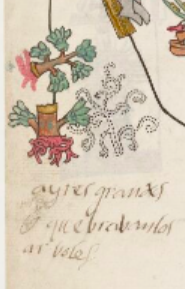ehecatl (TR46v)
This example of iconography shows the dotted lines of swirling wind (ehecatl) that were extracted from an image of a tree that broke due to the strong winds (see the contextualizing image and the cuahuitl). We have chosen to label this iconography with the Nahuatl term ehecatl, because that seems the likely choice for translating "ayres grandes" (big winds) mentioned in the gloss. Also, winds tend to swirl, as we see coming out of the "beak" or wind tube of Ehecatl, the divine force of the wind (below).
Stephanie Wood
The high volume of swirls could also support the reduplication of the first syllable, and the quantity of swirls suggests the greater force of wind (ehecatl) or air or breath (ecatl).
Another example of dotted volutes in this collection is a tlacuilo's representation of death by starvation (mayanalo, "there is starvation"). See below.
Stephanie Wood
ayres grandes
aires grandes
Stephanie Wood
1578
Jeff Haskett-Wood
aires, viento, winds
eheca(tl), wind, breeze, movement of the air, https://nahuatl.wired-humanities.org/content/ehecatl
el viento
Stephanie Wood
The Codex Telleriano-Remensis is hosted on line by the Bibliothèque nationale de France.
https://gallica.bnf.fr/ark:/12148/btv1b8458267s/f118.item. We have taken this detail shot from the indicated folio.
This manuscript is not copyright protected, but please cite Gallica, the digital library of the Bibliothèque nationale de France or cite this Visual Lexicon of Aztec Hieroglyphs, ed. Stephanie Wood (Eugene, Ore.: Wired Humanities Projects, 2020–present).



